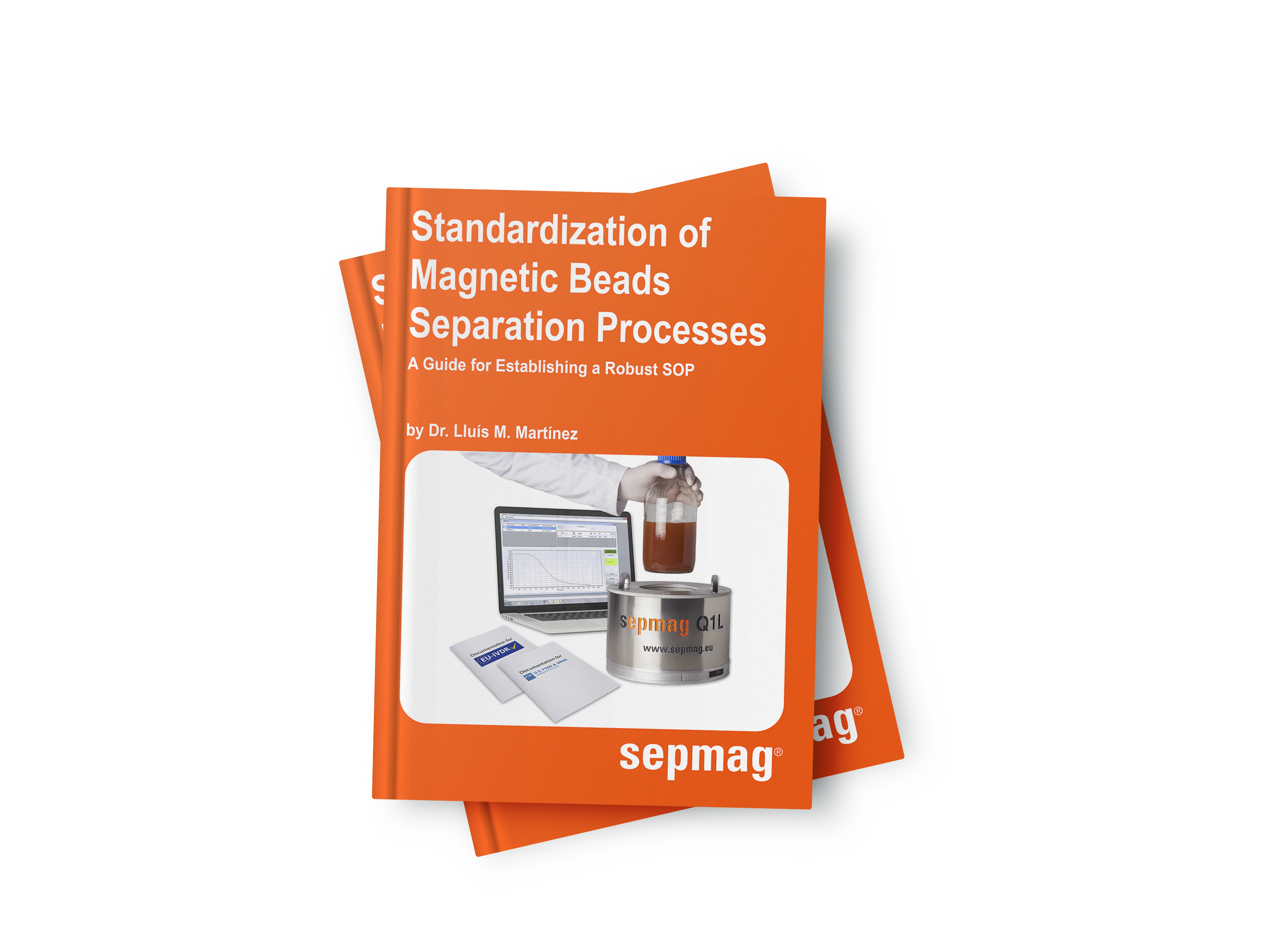Biomagnetic separation has a growing range of applications in life sciences, from cell sorting to protein purification. For any application, correctly specified parameters are key to cost-effective, reproducible magnetic separation protocols that can be successfully scaled up from R&D to production.
Biochemists coming to magnetic beads separation for the first time often know exactly how to control key parameters such as bead chemistry, sample volume, bead concentration, and wash buffers. However, many new users run into issues when it comes to specifying magnetic strength. Correctly specifying each of these parameters makes it easy to manage the quality, safety and costs associated with your magnetic separation protocol, and ultimately allow you to standardize your process.
As discussed in the previous chapter, when developing magnetic beads separation protocols, users must correctly specify key parameters involved in the process, including:
- Magnetic bead surface chemistry
- Sample volume and concentration
- Wash and elution buffers
- Magnetic strength
When deciding how to specify each of these parameters, there are 5 important factors users should consider:
Quality Control
Checking that you are following your protocol’s steps correctly, and that the process is proceeding as expected is important for any biochemical protocol, including biomagnetic separation. For a biomagnetic separation protocol, measuring the volume, dried sample weight, concentration, pH, and conductivity provides important information on your process, and allows you to control and optimize key parameters. As such, for the first three key parameters: magnetic bead surface chemistry, sample volume and concentration, and wash and elution buffers, this is relatively straightforward.
However, new users are often less certain about how to assess whether the magnetic strength is correctly specified throughout the process, or that the magnetic separator itself is performing as expected.
Scale Up
Your protocol should describe how to scale up your separation process to larger volumes. For most components of the protocol, biochemists will be familiar with exactly how to increase the working volume while keeping the chemistry reactions and concentration consistent. This means that scaling up the majority of factors involved in your process will likely be simple.
However, biomagnetic separation processes also require users to keep the magnetic parameters constant. When moving to larger volumes, magnetic strength needs to be scaled up correctly to maintain the same influence over your process as at smaller volumes, which is something many users find far more challenging.
Cost
For industrial applications, cost is a key factor. Users must consider the material and operational costs, as these have a substantial impact on the overall cost of the protocol. In some cases, however, the raw materials aren’t the most expensive part of your protocol. Sometimes, the way the process is carried out will contribute to your overall costs, even if the process is quality controlled. In the case of biomagnetic separation protocols, incorrectly specified parameters can waste time, resources, and materials, and increase the overall cost of the protocol.
Safety
Safety is an important consideration for any laboratory process. This includes avoiding risk during manufacturing, and also avoiding environmental damage both during manufacturing and during the product's lifetime and disposal. This may mean avoiding, or limiting the use of, certain chemicals and biological products. It also means using the correct equipment and tools. However, the personal and environmental risks posed by working with magnets is something that many scientists are unfamiliar with.
Standardization
The final factor that scientists should consider when designing a magnetic separation protocol is standardization. Standardizing the raw materials, tools, and operations is key to easily specifying and controlling each of the factors we’ve discussed so far:
- Quality Control
- Scaling Up
- Cost
- Safety
However, while creating well-defined standards for the raw materials, volumes, mixing, and other operations is relatively straightforward, doing the same for the magnetic rack itself can seem more complicated. As a result, many users are unaware or unable to correctly describe the intrinsic nature of the physics behind the magnetic separation process. This can cause problems with cost, efficiency, and especially when attempting to scale up the protocol.
The paramount importance of accurately defining key parameters, such as magnetic bead surface chemistry, sample volume, concentration, wash and elution buffers, and magnetic strength, is underscored for cost-effective and reproducible protocols that seamlessly transition from R&D to production. The previous chapter elucidates five critical considerations in the specification process: quality control to ensuring correct protocol adherence; scale up, particularly in the challenging task of maintaining magnetic parameters at larger volumes; cost which encompasses material and operational expenses; safety in highlighting the unique risks associated with working with magnets; and standardization through emphasizing the need for well-defined standards for raw materials, tools, and operations, including the intricate physics of the magnetic separation process. By addressing these considerations, users can not only enhance the quality, safety, and efficiency of their biomagnetic separation protocols but also facilitate scalability and standardization across diverse applications and volumes.
Biomagnetic separation system for processing up to 20 L of magnetic beads suspension

Related news:
- Targeted Magnetic Microsphere Delivery of DNA to Encourage Vascular Endothelial Growth
- Controlling Mesenchymal Stem Cell Growth with Magnets in Lieu of a Scaffold
- Magnetic Particles in Fluorescence Activated Cell Sorting




